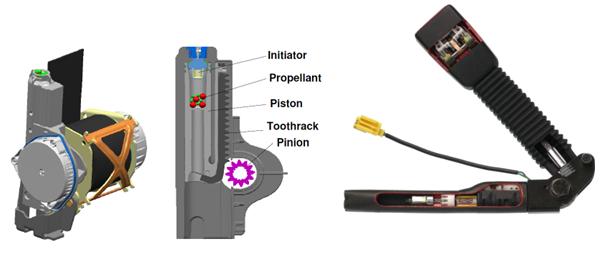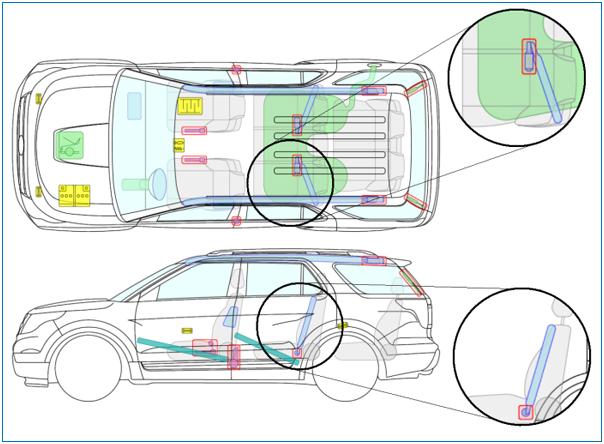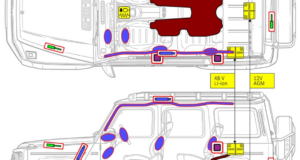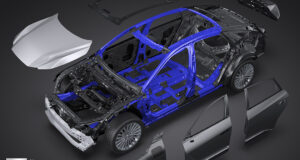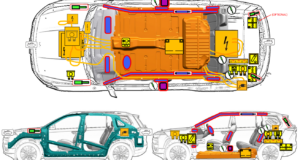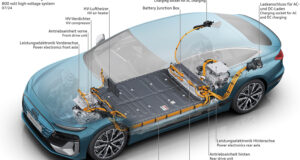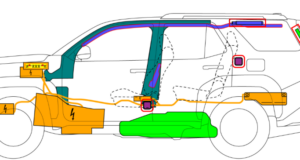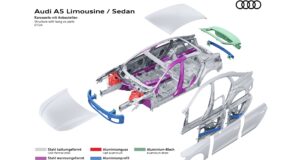The automotive industry has changed the way first responders approach a motor vehicle accident compared to a decade ago. Air bags are standard equipment, pretensioners are used in second and third row seats, and the seats are starting to resemble a firefighter jet seat with the technology packed into a small package. Situational Awareness is the new catch phrase in the extrication world. First responders must be aware of hazards of a vehicle from bumper to bumper!
For years extrication trainers preached peel away the plastic interior trim to ensure an air bag gas inflator is not in the cut path. However, those days are long gone! What we need to start doing is a quick “trauma assessment” if you will on our vehicles before we make a cut to any pillar or roof structure. Once the interior trim is pulled off palpate any visible nylon air bag curtains close to the metal. Deployed gas inflators statistically do not pose a safety hazard if cut. However, the best stance to take is to never cut through a gas inflator because there is no method available to us to determine if the inflator is still charged.
Occupant sensors in the front seats are devices that measure the distance away from the steering wheel or dash and weigh the occupant to determine if the air bag should be deployed in a crash. Have you ever put your backpack on the passenger seat and notice that the “Air bag Off” light turns on? This is an example of the sensor weighing the load on the seat and determining that the occupant in the seat does not meet the minimum weight for the air bag to deploy in a crash.
Pretensioners
Seatbelt pretensioners tighten the belt a few inches to prevent the occupant from jerking forward in a crash. Pretensioners are mounted in two different methods, to the seat belt retractor located in a body pillar or on the seat structure. Front seat mounted pretensioners are typically mounted to the top of the seat adjustment track. Seat mounted pretensioners will moved the seatbelt buckle and not the seatbelt. A center console usually provides enough protection for first responders not to have to worry about any hazards from charged pretensioners.
Buckle mounted pretensioners uses gas stored in the tube to retract the buckle during certain crashes. Retractor mounted pretensioners like the TRW one in is set off by any electronically fired pyrotechnic charge which retracts the seatbelt by 80mm, which is more than three inches. During the earlier stages of a crash, the pretensioner removes excess slack in the seatbelt to begin effective occupant restraint.
Pretensioners are not reserved for front seat passengers. Many late vehicles like the Volvo have pretensioners in the rear seats. Pyrotechnic pretensioners in the rear seats can be buckle or retractor mounted. Many rear seats that are split into 60/40 seats have a metal tower that is thick and big that holds a high mounted seat belt retractor. This tower is located in the 60% seat or the larger of the two. If the seats are split up into 40/20/40 than the tower is located in the center or 20% seat.
Some vehicles have a pre-collision safety system that includes an electric motor-pyrotechnic pretensioner system. During a pre-collision event like extreme sudden hard braking, an electric motor in the pretensioners retracts the front seatbelts. Once the event stabilizes the electric motor will reverse itself. The pyrotechnic pretensioners function normally and separately from a motor-pyrotechnic pretensioner system.
Load limiting is a safety that is used to minimize belt-inflicted injuries. A basic load limiting feature is sewn into the belt webbing and stitches are designed to break when a certain load is applied to the belt. The belt extends when the stitches come apart and allow the sewn webbing to unfold. A mechanical load limiting device use
Air bags
Air bags entered the automotive market as an air bag in the driver’s steering wheel. In 2011 model year vehicles, 10 different air bags in per vehicle are no longer a feature reserved for expense luxury vehicles. Automakers proudly advertise air bags on the vehicle interior on the steering wheel, bash panel, and pillar trim panels.
Seat Air bags
Seat mounted air bags are not a new hazard facing first responders. The difference is in the size and numbers of air bags packaged in a  seat are changing. Front seats can have two separate air bags to protect the occupant during a crash. This number is expected to increase when centered mounted seat air bags are used. Seat air bag are located along the outside of seat back frame and the bag is stored in a deflector called a “Taco” that directs the air bag when deployed.
seat are changing. Front seats can have two separate air bags to protect the occupant during a crash. This number is expected to increase when centered mounted seat air bags are used. Seat air bag are located along the outside of seat back frame and the bag is stored in a deflector called a “Taco” that directs the air bag when deployed.
Center Mounted Seat Air bag
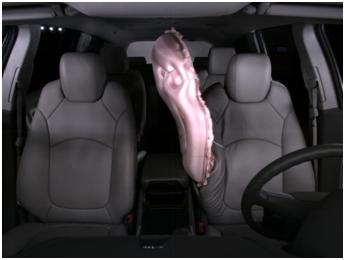 General Motors has developed a front center air bag deploys from the right side of the driver’s seat and positions itself between the front row seats near the center of the vehicle. The tubular tethered air bag is designed to act as an energy absorbing cushion between driver and front passenger in side crashes. The air bag will also be deployed during a rollover. The center mounted seat air bag will be in the Buick Enclave, GMC Acadia, and Chevrolet Traverse starting in the 2013 model year. Toyota developed a rear center console with an air bag that deploys between the rear passenger seats. Toyota has not put this air bag into production yet, but it is likely to make into a vehicle platform soon.
General Motors has developed a front center air bag deploys from the right side of the driver’s seat and positions itself between the front row seats near the center of the vehicle. The tubular tethered air bag is designed to act as an energy absorbing cushion between driver and front passenger in side crashes. The air bag will also be deployed during a rollover. The center mounted seat air bag will be in the Buick Enclave, GMC Acadia, and Chevrolet Traverse starting in the 2013 model year. Toyota developed a rear center console with an air bag that deploys between the rear passenger seats. Toyota has not put this air bag into production yet, but it is likely to make into a vehicle platform soon.
Side Air bags
Occupant ejection mitigation is new safety requirement that the automakers must meet by 2017. Side air bags and glazing of side window glass are the methods being tested and engineered into current model vehicles. These air bags will be large volume that can run from A-pillar to D-pillar. The 2011 Grand Caravan has a side impact air bag over nine feet long and is inflated by a stored gas inflator the size of a child’s lunchbox thermos and has over 10,000psi!
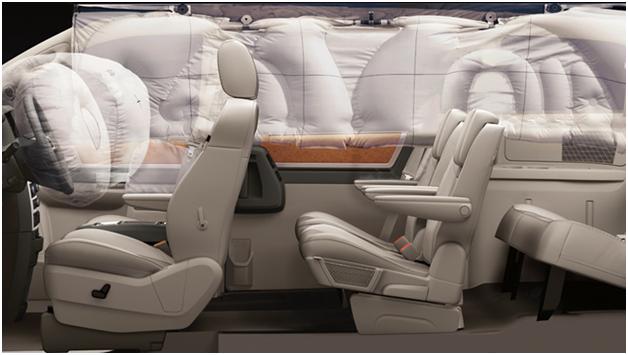
2011 Dodge Caravan Side Air bag
Knee Air bags
Knee air bags are typically located underneath the steering wheel on the angled portion of the instrument panel. The knee air bag module is a rectangle box easily package as a complete air bag systems with the gas inflator inside. This helps during installation at the auto plants and allows this system to be used in different vehicles.
Door Air bags
Many luxury auto makers have started installing door air bags. The air bags are typically installed in the center of the door.
Airbelts
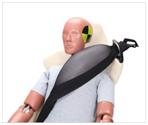 The 2011 Ford Explorer was the first production vehicle to have inflatable rear seat belts. Ford plans to offer inflatable seat belt technology in vehicles globally in the future. What is important to remember is the airbelt requires a stored gas inflator store in the seat. A pioneering company, Moditech, provides current information on hazards inside and outside the vehicle. Moditech developed the Crash Recovery System (CRS) and the image below of the 2011 Ford Explorer.
The 2011 Ford Explorer was the first production vehicle to have inflatable rear seat belts. Ford plans to offer inflatable seat belt technology in vehicles globally in the future. What is important to remember is the airbelt requires a stored gas inflator store in the seat. A pioneering company, Moditech, provides current information on hazards inside and outside the vehicle. Moditech developed the Crash Recovery System (CRS) and the image below of the 2011 Ford Explorer.
Key Fobs
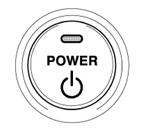 Keyless ignition is nothing new but many automakers are offering the features on their vehicles. Hyundai offers keyless ignition with a key fob or smart key that works on proximity. So how do you turn the car off if there is no key in the ignition? Most vehicles have a “Start” or “Power” button that is used to switch the ignition from off, to on, or to ACC. Make sure you the button indicator light is off. If you see a “READY-ON” light on the display the vehicle is started. This is very important with hybrid or electric vehicles because of the quiet operation. An important note, on some vehicles the “Power” button indicator light turns off when the vehicle is started. That is why it is important to make sure you do not see “READY-ON”!
Keyless ignition is nothing new but many automakers are offering the features on their vehicles. Hyundai offers keyless ignition with a key fob or smart key that works on proximity. So how do you turn the car off if there is no key in the ignition? Most vehicles have a “Start” or “Power” button that is used to switch the ignition from off, to on, or to ACC. Make sure you the button indicator light is off. If you see a “READY-ON” light on the display the vehicle is started. This is very important with hybrid or electric vehicles because of the quiet operation. An important note, on some vehicles the “Power” button indicator light turns off when the vehicle is started. That is why it is important to make sure you do not see “READY-ON”!
Batteries
First responders are aware of hybrid and plug-in electric batteries inside of the passenger compartment. However, 12-volt batteries can also be found inside of the passenger compartment. For example, the GMC Acadia has the 12-volt battery located in the floor behind the front passenger seat.
Is that vehicle totaled?
Late model vehicles have dozens of safety systems that keep occupants safe during a crash or rollover. Just because the vehicle may look repairable does not necessarily mean it is. Plastic interior trim panels and seat covers are designed to rip or tear when air bags deploys. Seat structures are engineered to distribute the load of an occupant. Seatbelts can have rip stitching to absorb energy from the occupant. Pyrotechnic pretensioners are onetime use. Keep in mind that most of the time in a serious accident the glass is already broken out and the windshield typically has spider marks from the air bags or occupants. Never let the fear of “totaling” a vehicle compromise patient care. Just remember all the hazards mentioned in this article are real and in vehicles.
 Boron Extrication An in-depth look into vehicle extrication and rescues involving today's automobiles
Boron Extrication An in-depth look into vehicle extrication and rescues involving today's automobiles
